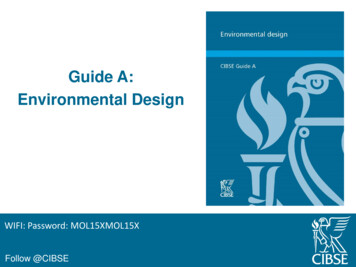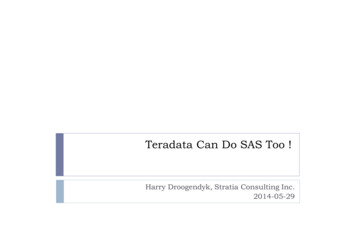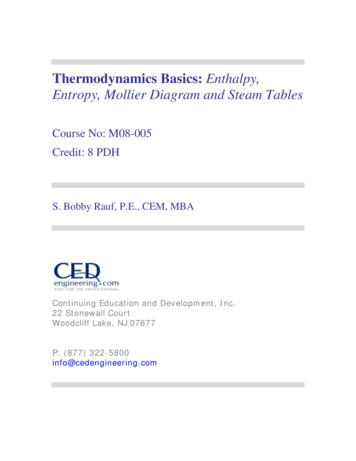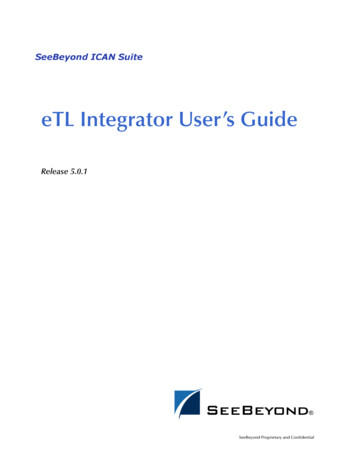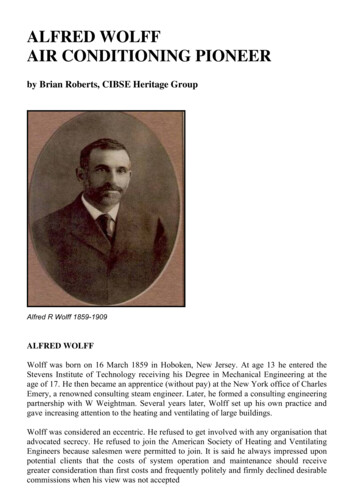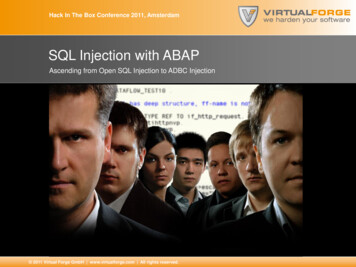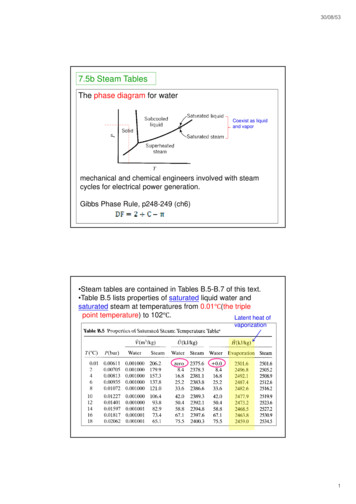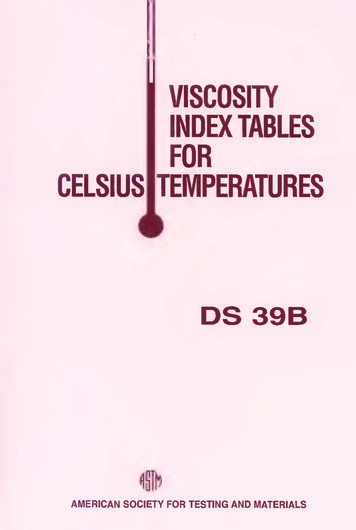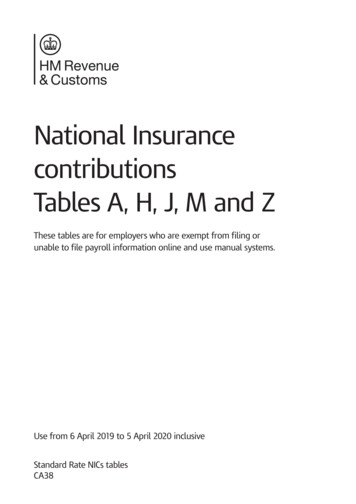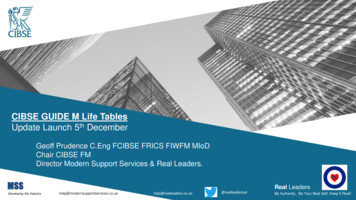
Transcription
CIBSE GUIDE M Life TablesUpdate Launch 5th DecemberGeoff Prudence C.Eng FCIBSE FRICS FIWFM MIoDChair CIBSE FMDirector Modern Support Services & Real Leaders.RLMSSDeveloping the IndustryReal aders.co.uk@realleadersukBe Authentic, Be Your Best Self, Keep It Real!
Thank You!Geoff PrudenceDirector/ChairmanProperty, FM &Building ServicesGroupsGeoff Prudence C.Eng FCIBSE FRICS FIWFM MIoDAndrew GreenSteve TomkinsTechnical Author,RICS NRM 3Head of BusinessDevelopmentSFG20help@realleaders.co.uk
CIBSE Guide M – 2nd Edition 2014Geoff Prudence C.Eng FCIBSE FRICS FIWFM MIoDhelp@realleaders.co.uk
CIBSE Guide M Life Tables – Supplement (App 12.A1)From CIBSE’s perspective, this document provides the indicativeeconomic life expectancy tables that are important to the industryfor robust life cycle asset renewal planning. It also provides the UKindustry consensus view of the ‘common data classifications’ forall building engineering services, by bringing together: CIBSE Guide M,RICS (NRM 1 and 3) andBESA’s SFG20 maintenance standards.This common data classification may be used by clients, facilitiesmanagers, consultants and contractors to provide structured assetinformation needed for the implementation of building informationmanagement (BIM) and effective data exchange during projects andat handover into operational phases and throughout the asset lifeReal Industry Collaboration CIBSE/CIBSE FM RICS BESA SFG 20 Leading Common StandardsDhelp@realleaders.co.uk
“ Operational Expertise and Systems Thinkingin the Design Process- is Essential”Initial DesignRefurbishment/Re-fitMaintenance StrategyOngoing Risk ReviewsLife/Plant Replacement(using CIBSE life tables)Geoff Prudence C.Eng FCIBSE FRICS FIWFM MIoDhelp@realleaders.co.uk
CIBSE Guide M - Chapter 3 Maintenance StrategyDesign StageBuilding Operation StageClients’ requirementsMaintenance policyControl of maintenanceStatutory Inspection frequenciesManufacturer recommendations‘Standard’ maintenance frequenciesBuilding the appropriate StrategyBuilding PrioritiesMaintenance PrioritiesLife-cycle considerationsSpecific requirementsAdjustment of maintenance frequenciesGeoff Prudence C.Eng FCIBSE FRICS FIWFM MIoDhelp@realleaders.co.uk
Added Value -Effective Maintenance Strategies and DeliveryCollaboration of Best Practice - Who Shares Wins!CIBSE Guide M Maintenance engineering & managementDesignStandardsPlan of DesignStandardsPlan of WorkBIM/1192.3/4SFG 20BS 8544NRM 3“Plan, Do,Check, Act iesAssessmentof Need.FunctionsBuilding Operational Risk Management and ComplianceBIM/1192.3/4Operational Best Practice-Standards (CIBSE,BSRIA, RICS, BIFM, BS etc)Source - Geoff Prudence/CIBSE Guide MGeoff Prudence C.Eng FCIBSE FRICS FIWFM MIoDhelp@realleaders.co.uk
Competency and CompetencyManagement Systems in FM“KS21 is not intended as a definitive work, nor is it amodel solution to achieve and maintain competency inevery case.It is however a useful guide for buildingowners, maintainers and operators, and facilitiesmanagers as to how they can demonstrate the effectivemanagement of individual competency and in so doingcontribute to corporate competency.”Foreword by Geoff PrudenceGeoff Prudence C.Eng FCIBSE FRICS FIWFM MIoDhelp@realleaders.co.uk
Building Operational Risk Management BORMCorp Real Estate/ Portfolio acilitiesManagersService Providers/Building ServicesManagementDesign, Operation and Delivery of Efficient Buildingshelp@realleaders.co.uk
Real Leadership in Building Services/The Built EnvironmentCore Business StrategyOrganisational Objectives & Values (Including CSR, Sustainabilityand EnergyEmotional EnvironmentProperty & Asset Strategy and subsequent Financial/Resourcing StrategiesReal CollaborationAI Authenticity & IntegrityEmotional Environment‘ Workplace’Technology(Enabling Ability)PhysicalControlsAutomationBMS/CAFMSmart BuildingsSmart WellbeingCompetenceCIBSE Guide M Maintenance Engineering & Management(Incl. A.12 Life Updates 2019)DesignStandardsPlan of DesignStandardsPlan of WorkBIM/1192.3/4SFG 20BS 8544NRM 3“Plan, Do,Check, Act iesAssessmentof Need.FunctionsBuilding Operational Risk Management (BORM) and ComplianceBIM/1192.3/4Operational Best Practice-Standards (CIBSE,BSRIA, RICS, BIFM, BESA/SFG20 BS/ISO etc)Real LeadersBe Authentic, Be Your Best Self, Keep It Real!Geoff Prudence 2019 Real Leadershiphelp@realleaders.co.uk
CIBSE Guide M Indicative Life Expectancy TablesAvailable as free ‘Download’ fromwww.cibse.org/GuideM-Supplement,to all Members and non-MembersReal Industry Collaboration CIBSE/CIBSE FM RICS BESA SFG 20 Leading Common StandardsDhelp@realleaders.co.uk
CIBSE GUIDE M – Update to theIndicative Life Expectancy TablesSupplement to Guide M – Appendix 12. A1Andrew GreenFRICS, ACIBSE, VC SFG20 Technical StandardsRICS Technical Author of NRM 3Rules of Measurement for Maintain and Renewal
CIBSE Guide M - Life TablesNRM perspective on Life TablesThe rationale behind the RICS New Rules of Measurement (NRM 3)was to be able to integrate the construction cost management withasset renewals and operation and maintenance, to the end of life.Based on cross-industry collaboration between RICS, BESA (SFG20) &CIBSE, the economic life expectancy table brings together theseindustry data standards into one combined table (appendix 12 A1)Therefore, the update CIBSE Guide M table is important in providingthe common data classification for overcoming the capital andrevenue divide, (i.e. BIM handover into facilities management) alongwith its impact on how buildings can be handed over into operation.Also it will help to structure and standardise how future conditionsurveying is undertaken and inform forward asset renewal plans.This 2020 update to the CIBSE Guide M table is essential to help futureconstruction projects to be more robustly life cycle costed in use,by providing the common data classification enabling handover ofasset information post-construction. Then use for the effectiveoperation and maintenance throughout the asset’s life cycle.
CIBSE Guide M - Life TablesHeat source - BoilersNRM 3cost codeCIBSEReferenceService Life(years)SFG20MaintenanceTask code(Oct 2019)
Product Data Definitions 2016BIMToolkitSource – Product data definition guide 13 April 2016 (on behalf of BIM task group)CIBSE Life table(revision 2019)
RICS new rules of measurement (nrm)‘What can be measured can be evaluated, improved, directed – in short managed’Lord Kelvin
Barriers to the use ofWhole Life CostingNAO 2005 Report on ‘Improving PublicServices through Better Construction’‘’Whilst the majority of the industry now recognise that whole life costing is thebasis for getting best value for money in public sector construction procurementHowever there are 4 key barriers to making this happen in practice’’ :1 Confusion over scoping and terminology and definitions (inconsistency)2 Lack of a common methodology and UK standard cost data structure3 Lack of ability to present information to enable project stakeholders tounderstand the inter relationship between costs (over the whole life),time and quality and also take account of wider environmental (notablyenergy performance and CO2 emissions) and also social aspects4 Lack of tangible evidence and the know- how (skills) to make it happen!
International Cost Classificationswith Life cycle costing (ICMS-2)ICMS-2 overcomes confusion over scoping whole life costs and terminologyregarding the difference between whole life cost (WLC) and life cycle cost (LCC)Whole Life Cost(WLC)Acquisition &Other Client’sCost (AC)CConstructionCost (CC)AssociatedCost (AC)Income(IC)Life Cycle Cost(LCC)RORenewalCost (RC)OperationCost (OC)MMaintainCost (MC)Externalities(EC)EEnd of LifeCost (ELC)AssociatedAssociatedAssociatedAssociatedcosts included in otherclient- non constructioncostsin BS ISO 15686-5Cost(AC)Cost(AC)Cost (AC) Note – OccupancyCost (AC)
ISO 19650 part 3 – BIM into FM and whole lifeDesign andConstructOperate andMaintain Push FinancesChanging Service ExpectationReadiness of Service UsersTechnology SolutionsKnowledge of AssetSkills (3D and 5D/6D/7D)PullDigital Built BritainSmart CitiesSupply Chain ImpactGovt Soft LandingsOpen Data StandardsBenefits RealisationCost efficiency (VfM)
Asset Management – ISO 55000 Maturity 0-521Developing45CompetenceKnowledge BasedExcellenceOptimized planning& decision makingA “paradigm shift” in attitude from‘cost focus’ to ‘business focus’Repair as goodas beforeReactive – fix itwhen it breaksIntegrated organization,systems & processesProactive predictivemaintenanceStruggling withmanagement systemsSystems are a valuable tool- information is an assetProactive, preventivemaintenanceLearningApplyingMaintenance is an expenseEmbeddingOutsourced contracts todeliver value & cost savingsSound knowledge ofcost, performance &risk relationshipsIntegratingOptimizingMaintenance is an investmentPerformance & ReliabilityMaintenance & Renewal SpendInnocence3
CIBSE Guide M – Update to IndicativeLife Expectancy Tables (App 12.A1)Thank YouFor more information contactandy.green@atkinsglobal.com
SFG20Simplifying the world of buildingMaintenance, making it easier toshare and reuse data.Unifying the data structures(common language)Steve TomkinsC.Eng MIMechE MCIBSE MIAM
SFG20 Perspective on the CIBSE Guide M – Life Tables Update (App 12.A1)The CIBSE Guide M life table update now fully aligns CIBSE’s referenceservice life expectancy data with SFG20 maintenance codes and to NRMfor all building engineering services assets.It incorporates additional SFG20 maintenance tasks schedule codes from2014 to 2019 (October) from 800 (2014 Guide) to 1200 SFG20 schedulesDivider slideThe benefits to SFG20 subscribers are: SFG20 applications now aligned to NRM for costing of maintenance Supports industry foundation data standards for use on future designand construction projects standardise asset mapping to SFG20 codes Rationale for use of the ‘common asset structure’ throughout the entirebuilding (construction) and asset (maintenance and renewal) life cycles
SFG20 Latest Content and Specialist Services SetsThe number of SFG20 task schedules has increase from 500(Guide M 2008) to 1200* and includes specialist services* As of October 2019Divider slideSchedules specific to an industry or sector: Healthcare – HTM aligned Access Equipment & Lifts Catering Operational Security & Surveillance Building Fabric Workshop Equipment Mechanical Handling Equipment
Common Language and Data Classification StructuresIndustry Data Classification StandardsDivider slideCIBSERICSBESANBSBest practisedesignprinciples andstatutoryobligationsIntegratesconstructionand costoperationsStandardisedmaintenance routineschedules andstatutory obligationsUnifiedClassification forUK ConstructionsectorAsset ListOmniClassConstructionClassificationSystem derivedfrom ISO and ICISUniformatStandard for classifyingbuilding specifications,cost estimating, andcost analysis in the U.S.and Canada
Unification of all the industry data classificationsBIM ModelAsset Structure & LevelsDivider slideMaintenanceAsset Renewals
SFG20 MappingConstructed AssetNRM(Cost Structure)Built AssetLocation/SpaceSystemLODGrouped Elements (1)TypeSiteElement (2)Divider slideAssetAttributesBIM Model(s)RegionBuilt AssetProductGeographical (Logistic)(Client Estate mLinkAIM3D ModelMaintain AssetsLocation CodeSystem/ ZoneAsset TypeSFG20 TaskUNICLASS/NRM /CIBSE/SFG20SystemAssetSub SystemMaintainable Set TitleSFG20 Set Main TitleSFG20 Set TitleSFG20 ScheduleSFG20 ScheduleSFG20 ScheduleSFG20 ScheduleCIBSE Guide M- Renewal Descriptors- Expectancy asset life- Factoring (to functionin use)
SFG20 MappingDivider slide
SFG20 solutions for use in a digitally enabled worldDivider slide
Working In PartnershipDivider slide
Thank youPanel QuestionsGeoff PrudenceDirector/ChairmanProperty, FM &Building ServicesGroupsAndrew GreenSteve TomkinsTechnical Author,RICS NRM 3Head of BusinessDevelopmentSFG20
additional SFG20 maintenance tasks schedule codes . from 2014 to 2019 (October) from 800 (2014 Guide) to . Uniformat. Standard for classifying building specifications, cost estimating, a
